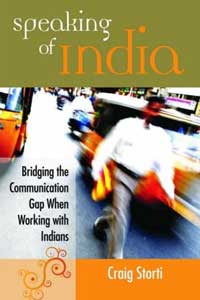Speaking of India, by Craig Storti, 2007.

Speaking of India remains one of the better guides out there for people in the business world interacting with India. Craig Storti has given us some great paradigms and concepts to help cultures work together better. This book is quick to read and should be on your shelf if you regularly interact with India.
Personally, Storti’s writings provided my foundation for understanding concepts like indirect and direct speech and how communication styles can differ across cultures. I owe a lot of my understanding to his ability to clearly talk about the issues at place and some strategies for solving them.
I’ve divided his better insights into culture, communication, and management.
Culture:
- Storti does a nice job of explaining which Indians he is talking about and limits his remarks to “educated urban professionals” working in the private sector. #IndiasNotIndia
- He stresses the impact of the extended family and group orientation in how Indians work. He cites examples like learning your place in the pecking order and learning how to get along with others. #See1See100
- “In the West, the central function of the family is to prepare its members to be able to live on their own, whereas in India, the central function of the family is to guarantee that no one ever has to live on his or her own.” (29)
Communication:
- Indians are going to tell you what they think you want to hear.
- Indians have a much heightened sense of nuance and will interpret your communication based on your body language, what you don’t say, the tone, etc.
- Indians have many different methods of saying “no” – delayed response, asking what you think, conditional yes, hesitation.
- Storti’s “Indirect/Direct/Blunt” model is a great eye-opener if you’ve never seen it.
Management
- Many Indian bosses will delegate responsibility, but not authority.
- Storti has a good list of how your leadership style might frustrate Indians you lead.
- He gives some very practical tips on how to encourage initiative.
- His advice on virtual teams is also good, particularly how you can build trust.
Where he comes short is not addressing the indirect speech of Westerners and categorizing all Indians as using indirect speech all the time, which I’ve dealt with in a previous article. In general, most books that came out about this time did not grasp the complete nature of Indian business relationships and some of his thoughts can come off as patronizing. Additionally, it assumes the only Indians in the business world are those who are working for you.
Who would like it: Anyone who will be working with Indians, especially if you are new to India and Asia. If you are a seasoned Asian manager, you might find some of the concepts a bit elementary, but they can still be a good refresher. While he does include some advice for Indians working with Westerners, I think his other books, such as Americans at Work, are a better read.
Buy Speaking of India on Amazon.com or Amazon.in





Craig also conducts fabulous seminars!
I’m sure they are great, but haven’t been to one myself!